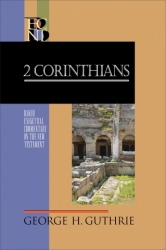Editor’s Note: Today we continue our Author Interview with Dr. George Guthrie, as he talks to us about his new BECNT commentary on 2 Corinthians … and about 2 Corinthians itself! If you missed Part 1 of this very helpful interview yesterday, you can catch up here.
Books At a Glance:
Sketch out for us how 2 Corinthians “hangs together” as a whole. Can you give us a broad, bird’s eye view of the epistle?
Guthrie:
Sure. As you probably know, one of the ongoing questions surrounding 2 Corinthians concerns the book’s unity — are we dealing with a single composition or several that have been cobbled together? I believe the book constitutes a single composition, a view that seems to be gaining momentum in current scholarship. No textual tradition exists that presents the book as anything other than a unified whole, and there are numerous literary dynamics that suggest a single composition.
For instance, the most striking argument for disunity has to do with the differences between the book’s first nine chapters and the last four, as well as the major shift in tone at 10:1. Yet, there exist no fewer than nine verbal parallels between 2 Cor. 1:1-7 and 13:11-13, Paul crafting an inclusio, a “bracketing” device meant to mark the beginning and ending of a discourse. Further, from the standpoint of rhetorical strategy, other works in the ancient world demonstrate that an author at times would leave an offensive confrontation of an opponent until the end of a composition, as Paul does with 2 Cor. 10-13. These are just a couple of arguments in favor of the book’s unity.
As for the flow of the discourse, after the letter opening and prologue in 1:1-11, the book lays out in three broad movements (and generally I am following James Scott at this point).
- First, in 1:12-7:16 Paul presents a rigorous defense of his apostolic ministry. Travel narrative begins and ends this movement, creating a tension in 2:12-13 with the absence of Titus, which is resolved with the coming of Titus in chapter 7. The focus of this first movement, however, lies in Paul’s theologically rich reflections on the nature of authentic ministry, found in 2:14-7:4. So, the apostle largely addresses the difficulties between him and the Corinthians in recent months and the momentary resolution of those difficulties, with the report of Titus.
- The second major movement, 2 Cor. 8-9, challenges the Corinthians to get busy preparing for their apostle’s upcoming visit by attending to the collection for the saints in Jerusalem.
- The third movement, chapters 10-13, further prepares for Paul’s coming by addressing the false teachers quite directly.
Thus, the whole book can be read as a series of ways in which Paul addresses the crisis of the moment (the church’s disillusionment with his ministry) and strategically seeks to again firmly draw them under the wing of his mission.
Books At a Glance:
What is distinctive about your commentary? What contribution are you hoping to make? What audience did you have in mind in writing? What impact do you hope the book will have?
Guthrie:
Much of commentary writing is what we might call “workmanlike.” So, the goal is not to be novel but rather to clarify systematically the meaning of the text, in line with the specific guidelines for the series for which you are writing.
At the same time every commentary writer has to come to grips with, “why am I writing yet another commentary on this book?” When you have excellent volumes by the likes of Harris, Thrall, Barnett, Garland, and many others on the shelf in front of you, you have to have a good reason for getting in the chair every day and putting words on the page! My hope was to contribute to broader conversations on how 2 Corinthians should be understood and to help those of us in the church to think about how we might faithfully engage this book for the good of the church, for the advancement of the Kingdom, and for God’s glory.
As for those broader conversations, I hope I have made a few contributions here and there on the interpretation of 2 Corinthians. For instance, my approach to the Triumphal Procession passage in 2:14-16 is based in part on neglected background information, some of which has not been dealt with by other commentators. I also tried to extend the conversation a bit on 3:7-18, another challenging passage, and my translation of 3:1 moves in a different direction that virtually all modern translations.
In terms of helping those of us in the church engage 2 Corinthians in fresh ways, I have tried to do a number of things. For example, much as with my NIV Application commentary on Hebrews, I start with a piece of historical fiction. I worked hard at researching ancient Corinth, both in terms of its layout and its culture. The fictional piece is based on rigorous research but presents that research in what I hope is a compelling format. By beginning the commentary with a brief, creative narrative, I wanted to draw the reader into Paul’s Corinth and Paul’s challenging ministry situation. My motive was pedagogical, to help the reader understand 2 Corinthians as profoundly relational, written to a specific cultural context and with specific ministry aims.
I also tried to think through the balance of the Introduction in a fresh way. I didn’t simply want to take a “normal” approach of addressing authorship, date, etc. So the structure of the Introduction departs a bit from the norm.
Finally, I wanted to give educated pastors help by modeling good exegesis (and the BECNT series has a wonderful layout that is conducive to that goal), but by also including great quotes and very practical reflection on the implications of the text. There is nothing more fulfilling to me than to have a pastor communicate to me that my commentary helped in the preparation of a sermon series. So if the commentary serves that end, I will feel the work has been worth it!
Books At a Glance:
What is some advice you might give to pastors who are considering preaching or teaching through 2 Corinthians?
Guthrie:
First, settle deeply into the book, reading it through numerous times. Listen to the beat of his ministry heart. “Hear” his struggles and allow the Spirit to draw appropriate parallels to your life and ministry. Walk with Paul in authentic ministry before trying to communicate about authentic ministry to others.
Second, be very careful as you move from the ancient to the modern context. There are aspects of Paul’s world — his rhetorical strategy for instance — that probably are not directly transferrable. Think carefully about how we might fully embrace Paul’s theology and principles for ministry while working to think through strategies appropriate to our cultural contexts. For instance, how might we confront false teachers in a way that will diffuse their influence on those to whom we minister? In general terms, we should work hard at the craft of communication, the teaching of strong doctrine, and the art of healthy relationships, but Paul’s forms of self-commendation and public confrontation might look a bit differently in our modern ministry situations.
Third, you might consider dividing the book into several series. For instance,
- 1:1-2:13 and 7:5-16 could be unpacked in a series on “Challenges to Life and Ministry.”
- The center section of the book, 2:14-7:4, could address “Hallmarks of Authentic Ministry.”
- “Being a Giver in a Get-All-You-Can World” could be a third series drawn from chapters 8-9.
- And “Dealing with False Teachers” might be a way to approach the final four chapters of the book.
2 Corinthians offers us a wonderfully rich resource for ministry, both in terms of our personal lives and our public proclamation. Getting at and communicating its riches take a lot of hard work, but we will find that such work pays great dividends both now and into eternity.

